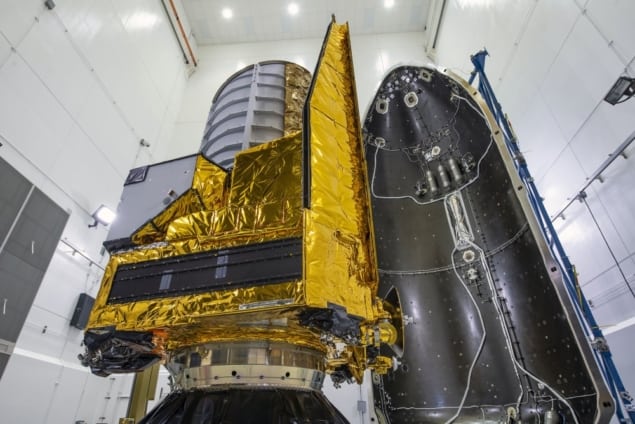
A craft to explore the nature of dark energy has been launched today aboard a Falcon 9 rocket from Florida’s Cape Canaveral Space Force Station at 11:12 local time. The €1.4bn Euclid mission will study the large-scale structure of the universe with the aim of understanding how it evolved following the Big Bang.
Over 25 years ago physicists were astounded by the discovery that the rate of expansion of the universe was increasing – not decreasing as had been previously thought. Many physicists believe that dark energy is the cause behind the accelerating expansion yet it remains one of the biggest mysteries in cosmology.
To better our understanding of the dark universe, Euclid – a space-based telescope made by the European Space Agency (ESA) – aims to create the most accurate map yet of the large-scale structure of the universe. It uses a 1.2 m-diameter telescope, a camera and a spectrometer to plot a 3D map of the distribution of more than two billion galaxies – a view that will stretch across 10 billion light-years.
At roughly 4.7 m tall and 3.7 m in diameter, Euclid will observe galaxies and clusters of galaxies at visible and near-infrared wavelengths, revealing details of the universe’s structure and its expansion over the last three-quarters of its history or some 10 billion years ago. Euclid will chart this expansion rate much further back in time than existing ground-based telescopes.
“The successful launch of Euclid marks the beginning of a new scientific endeavour to help us answer one of the most compelling questions of modern science,” says ESA director general Josef Aschbacher. “The quest to answer fundamental questions about our cosmos is what makes us human. And, often, it is what drives the progress of science and the development of powerful, far-reaching, new technologies.”
To boldly go
Euclid will now spend the next 30 days travelling to a spot in space called Lagrange Point 2 – a gravitational balance point some 1.5 million kilometres beyond the Earth’s orbit around the Sun. Once there it will then spend about three months in commissioning before studying the universe for at least six years.
Euclid was chosen for launch in 2011 and is a medium-class mission belonging to ESA’s Cosmic Vision 2015–2025. The mission was initially planned to be launched this year by a Russian Soyuz spacecraft rom Europe’s Spaceport in Kourou, French Guiana. But following international sanctions after Russia’s invasion of Ukraine, ESA sought out alternatives, choosing SpaceX and the Falcon 9 rocket in October 2022.
The Euclid consortium brings together over 2000 scientists in 300 labs in 17 different countries in Europe, US, Canada and Japan. The first data release is expected in 2025.
- SEO Powered Content & PR Distribution. Get Amplified Today.
- PlatoData.Network Vertical Generative Ai. Empower Yourself. Access Here.
- PlatoAiStream. Web3 Intelligence. Knowledge Amplified. Access Here.
- PlatoESG. Automotive / EVs, Carbon, CleanTech, Energy, Environment, Solar, Waste Management. Access Here.
- BlockOffsets. Modernizing Environmental Offset Ownership. Access Here.
- Source: https://physicsworld.com/a/european-space-agency-launches-euclid-dark-energy-mission/
- :has
- :is
- :not
- 1
- 10
- 11
- 12
- 17
- 2011
- 2022
- 2025
- 25
- 30
- 3d
- 7
- 9
- a
- About
- accelerating
- accurate
- across
- After
- agency
- ago
- aim
- aims
- alternatives
- and
- answer
- around
- AS
- At
- back
- Balance
- BE
- been
- before
- Beginning
- behind
- believe
- Better
- Beyond
- Big
- Big Bang
- Biggest
- Billion
- Brings
- but
- by
- called
- camera
- Canada
- Cause
- Chart
- choosing
- compelling
- consortium
- Cosmology
- Cosmos
- countries
- craft
- create
- Dark
- data
- Days
- details
- Development
- different
- Director
- discovery
- distribution
- drives
- energy
- ESA
- Europe
- European
- European Space Agency
- Europes
- evolved
- existing
- expansion
- expected
- explore
- far-reaching
- First
- following
- For
- Force
- French
- from
- fundamental
- further
- Galaxies
- General
- gravitational
- had
- help
- history
- How
- HTTPS
- human
- image
- in
- increasing
- information
- initially
- International
- invasion
- issue
- IT
- ITS
- Japan
- jpg
- Labs
- large-scale
- Last
- launch
- launched
- launches
- least
- local
- made
- MAKES
- many
- map
- max-width
- million
- Mission
- Modern
- months
- more
- most
- much
- Nature
- New
- New technologies
- next
- now
- observe
- october
- of
- often
- once
- ONE
- or
- Orbit
- our
- out
- over
- Physics
- Physics World
- planned
- plato
- Plato Data Intelligence
- PlatoData
- Point
- powerful
- previously
- Progress
- quest
- Questions
- Rate
- release
- remains
- revealing
- Rocket
- roughly
- russian
- s
- Sanctions
- says
- Science
- scientific
- scientists
- SIX
- small
- some
- sought
- Space
- Space Force
- space-based
- Spaceport
- SpaceX
- spend
- Spot
- station
- structure
- Study
- Studying
- successful
- Sun
- Technologies
- telescope
- telescopes
- than
- that
- The
- then
- There.
- this
- this year
- thought
- three
- thumbnail
- time
- to
- today
- together
- true
- two
- Ukraine
- understanding
- Universe
- us
- uses
- View
- visible
- vision
- was
- were
- What
- will
- with
- world
- year
- years
- yet
- zephyrnet













